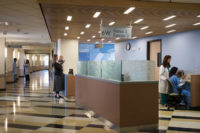Getting the word out, correctly, in time and to the right people, is an important mission for colleges and universities. Mass notification has become a key element of campus safety and security.
John Dellacontrada, assistant vice president of media relations at the University of Buffalo, New York, says he sought a “solution that we could deploy quickly and consistently, one that would work on desktop and mobile devices to get a message broadcast via various ways and that could work with our existing emergency public address system.”
For Jason Willis, chief of police at Northern Kentucky University, the importance of mass notification turned on reliability and ease of use. “We test campus-wide, with text, email, voice, Twitter and Facebook,” he says. “These days social networking is even more important.”
At Texas A&M University – San Antonio, Eric Coleman, the university’s chief of police, says, “Safety has always been our number one priority. We’ve always wanted to have a state-of-art security infrastructure. Other universities that have been around for years have different types of infrastructure, specifically emergency phones across their campuses. We wanted to have continuity across our campus and with that a system that was easy to expand and incorporate as our campus grows.”
Campus Wide Protection
Coleman installed emergency phones across campus. Phone towers were installed along walkways, parking lots, and access gates while each classroom was outfitted with an emergency phone. Unlike other universities where emergency phones are only located outdoors or in stairwells, Coleman saw it necessary to provide students with immediate communication to emergency personnel. This meant that students would never have to travel further than the corner of their classroom to summon assistance.
“When the units are activated they immediately connect to our dispatch center at the university police department,” says Coleman. “If our officers are self-dispatching, then the activated phone will connect to our officers’ handheld radios. When the phones are activated, we know exactly which unit it was and where it is on campus.”
Furthermore, each tower incorporates an integrated security camera on an extension arm. This allows the campus dispatch center to monitor activity across campus. The cameras also allow a dispatcher to access a situation at an activation point before an officer is dispatched.
In addition, Coleman was able to set up text messages, emails and broadcast messages from the towers.
For Dellacontrada, mass notification messaging is opt in, that is students agree to receive the messages. “We work closely with IT to maintain and update the lists and just use the system for emergencies but also test every week.”
Willis also has an opt-in system with more than 11,000 users that covers the public address systems as well as social media features.
Door Lockdown Tied to Notification
Mass notification can be tied to door controls.
For example, keypad-less standalone access control can be vandal-proof, wireless and features high-efficiency circuits for low-power consumption. In this case, Continental Access Control Networx wireless locks work at a leading private university. The system can lockdown doors at a specific site or across a campus.
Providing a Panic Button
Schools in Indiana, California, Idaho, Washington and Virginia have selected a real-time location system (RTLS) wireless panic button solution to keep students safe and improve school security.
An instructor wears an RFID safety badge, and in the event of a medical, disciplinary or other emergency, pulling down on the badge instantly makes their location known (e.g. “Room3, Medical Code Red”) to first responders and other badge-holders. Unlike hard-wired panic buttons, this safety badge is wearable and provides a wireless panic button and personal alarm device with location-tracking built-in, helping police minimize emergency response times by avoiding map look-ups and phone calls.
Software also allows officials to send mass notifications to faculty badges, displayed as text messages on the badge’s LED. In addition, the system automatically time-stamps and records all emergency events and resolutions for review by campus and police departments.
Wi-Fi Part of the Action
Demand for high-speed, reliable and secure Wi-Fi has tremendously increased at colleges and universities and it’s no longer only for residence halls and academic buildings. It also can be part of a mass notification and emergency messaging approach.
To provide guests attending sporting games, concerts and other events at the University of New Hampshire’s (UNH) Whittemore Center a more immersive and secure experience, the institution, in partnership with Enterasys Networks, expanded its wireless network to include the multi-purpose arena. The Whittemore Center is one of the first collegiate arenas to provide 100-percent Wi-Fi access to guests, enabling up to 7,500 concurrent users to use social networks, upload photos and videos and access real-time information when they want.
This year, over a quarter of a million guests will be given 100-percent Wi-Fi access during UNH sporting and community events, family shows, tradeshows and concerts.
Joanna Young, CIO, University of New Hampshire, says, “The decision to expand wireless access to the Whittemore Center was easy, and it speaks to the joint mission of UNH and Enterasys to deliver fast and secure Wi-Fi for students, faculty, staff and guests across the entire campus. Our goal was to provide a network that not only lends itself to the immersive experience that’s become so important to fans and guests, but to also provide peace of mind that information shared across the network is safe and secure. Enterasys was able to deliver on both of these criteria, and it demonstrates the company’s deep understanding of our needs.”







